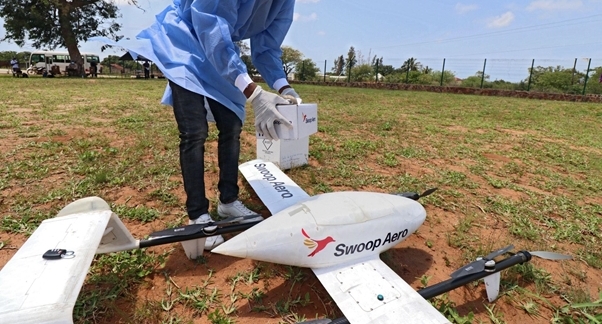‘Drone delivery solutions need to reach a stable operating model to generate evidence on the true cost of operations at scale'
Working to improve the medical logistics in Africa, VillageReach helps test and integrate drones into existing public health systems and seek new markets. By building tools for evidence-building on the impact of drone delivery, VillageReach is now hoping to scale its network and publicise evidence of drone services in

Working to improve the medical logistics in Africa, VillageReach helps test and integrate drones into existing public health systems and seek new markets. By building tools for evidence-building on the impact of drone delivery, VillageReach is now hoping to scale its network and publicise evidence of drone services in DRC and Malawi and improve systems to distribute medical supplies to rural Africa.
Lakshmi Ajay from Logistics Update Africa talks to Gabriella Ailstock, manager, Health Systems Group, VillageReach
What are some of the good policies or good practices that were conceived by some of the governments you have worked with when it comes to building a strong drone ecosystem?
Since 2015, VillageReach has been at the forefront of the exploration of drone technology to transport life-saving products in challenging environments. VillageReach is currently working with the governments of Malawi, the Democratic Republic of Congo (DRC), Mozambique, and the Central African Republic (CAR) to test and integrate drones into the existing public health supply chains. Currently, we are operating two drone delivery networks in Malawi and DRC serving over 50 hard-to-reach health facilities. We are in the planning stage with the government of Mozambique to begin operations in late 2021 or early 2022. We work with the ministries of Health in these countries to identify the appropriate use of drones and the type of drone technology or services that are the best fit to the local context and supply chain challenges. One primary role we play is coordinating relationships between drone service providers and public and private sector clients to integrate their services into the public health supply chain and open new markets for additional drone services. In DRC and Malawi, we have also fostered the establishment of multi-sectoral government drone working groups to put in place mechanisms for collaboration and coordination of drone activities across sectors. These groups include a variety of actors including civil aviation authorities, security agencies, and the Ministries of health, agriculture, education, NGOs, donors, and UN agencies. We have found the formation of these groups to be a successful strategy to develop a vibrant drone ecosystem.
You had mentioned working on evidence generation toolkits for governments for drone integration in public systems, especially healthcare. What are some insights you can share with us on this?
VillageReach has identified a critical gap in the medical drone delivery sector: a lack of publicly available evidence on the cost-effectiveness and impact of drone transportation in low- and middle-income countries. Without this data, governments and private sector clients are hesitant to invest in establishing large-scale drone transportation systems, stagnating progress towards transforming healthcare delivery. To help fill this gap, VillageReach launched two interlinked tools – The Drone Evidence Generation Toolkit and the Medical Drone Delivery Database. The toolkit provides resources and guidance to help implementers collect the right data for stakeholders to make evidence-based decisions on medical drone delivery operations. To provide a public platform to share this evidence, we then developed the Medical Drone Delivery Database. Through an iterative consultation process with other members of the UAV for Payload Delivery Working Group, which VillageReach coordinates, we launched the second version of the Drone Evidence Generation Toolkit this October. We have also observed that implementing partners and donors have not typically dedicated sufficient time or resources to generate the right data they need to make decisions. For example, implementers should compare the results of established drone operations to the status quo ground transport. This requires collecting data on supply chain performance, supply chain costs, and health outcomes before drone flights begin and 6-12 months later, at the very minimum. This requires dedicated financial resources and specialized human resources with expertise in supply chain monitoring and evaluation and supply chain costing.
What kind of work with respect to drones did VillageReach undertake during the pandemic and post-pandemic?
VillageReach began our routine drone operations in the Equateur Province DRC during the pandemic, which was extremely challenging. Although we did experience setbacks due to the pandemic, we knew that we needed to work even harder in order to set up a responsive supply chain that could be utilized to support COVID-19 response and is ready for COVID-19 vaccine delivery. Across DRC and Malawi, we have utilized our networks to transport PPE, COVID-19 lab samples, and COVID-19 vaccines to and from hard-to-reach facilities. In Malawi alone, our drone service partner, Swoop Aero, has transported over 6,800 doses of the COVID-19 vaccines. 
Gabriella Ailstock, Manager, Health Systems Group, VillageReach
Could you briefly tell us about VillageReach’s work with Swoop Aero, in southern Malawi and its coverage in the different districts of Malawi?
VillageReach and Swoop Aero began working together in Southern Malawi in May of 2021. We build on the success of a project previously funded by FCDO and UNICEF to continue supporting drone delivery networks in Nsanje and Chikwawa districts in Southern Malawi. Since then, we have been working with the Malawi Ministry of Health on a national scale-up plan to reach 100+ hard-to-reach facilities across Malawi. Currently, we are serving 27 health facilities across Nsanje and Chikwawa and recently began setting up operations in the district of Mangochi.
What are some of your plans in 2022 to make sustainable drone networks possible in the public sector and for revenue generation from the private sector?
VillageReach believes that a drone delivery solution with diverse revenue sources beyond the public health sector has the greatest chances of achieving financial sustainability. This is a potential new model for drone delivery services in low and middle-income countries, which private sector investments could catalyze. But before this happens, drone delivery solutions need to reach a stable operating model to generate evidence on the true cost of operations at scale. This is an essential first step in order to forecast a pricing structure for customers outside of the public health system. In the next year, we are working towards this first step of scaling our networks and publicizing robust evidence on the cost of drone services in DRC and Malawi.
Can you briefly outline the work you have done with Gavi and the Vaccine Alliance Working Group till now, with respect to building the drone ecosystem?
In addition to supporting drone deployment in Rwanda and Ghana, Gavi has been a funder of our work in DRC since 2018. Gavi contributed to the drone ecosystem by funding the generation of evidence on the cost-effectiveness and impact of drone operations, which is critical to scaling and sustaining operations across Africa.
Could you specify which are the kind of drones, airships, and drone companies working with VillageReach for delivering humanitarian logistics?
VillageReach seeks to find the best partner based on implementation and operational needs, therefore there is not a particular type of drone technology or type of company that we work with. We work with our government partners to assess the public health supply chain needs and local contextual factors to determine what type of drones could address the local context. After identifying the type of technology, we release public requests for proposals to solicit bids from companies that can meet our minimal technical qualifications. VillageReach and our government partners assess the proposals together and jointly select drone service providers. In Malawi, Mozambique, and DRC, eVTOL aircraft meet the current supply chain needs, but in CAR we identified a need for longer-range VTOL aircraft.
This interview was originally published in Logistics Update Africa' November - December 2021 issue.


